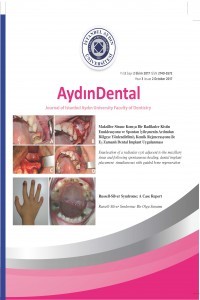Rezin Nano Seramik Endokron: Post-Kor Destekli Kron Restorasyonlara Bir Alternatif
Giriş Endodontik tedavili dişlerin uzun ömürlü olması, büyük oranda diş yapısının korunduğu uygun bir restorasyonun seçimine bağlıdır. Bu perspektifte, endokronlar post-kor restorasyonlara uygun bir alternatif olarak değerlendirilebilir.Amaç Arka grup dişlerde CAD/CAM rezin nanoseramik endokron restorasyonların klinik etkinliğinin değerlendirilmesi. Olgu Raporu 37 yaşındaki erkek hasta ağrı şikayet ile kliniğimize başvurmuştur. Klinik ve radyografik incelemeden sonra, 14, 25, 26 nolu dişlere 3 adet endokron planlanmıştır. Endokronlar CEREC 3D yazılımı kullanılarak taranıp dizayn edilmiş ve CAD/CAM rezin nanoseramik blok kullanılarak kazınmıştır. Bir yıllık takip sonucunda endokronlarda herhangi bir çatlak, çürük ve desimantasyon gözlenmemiştir. Klinik bağlantı Endokronlar arka dişlerin restorasyonunda, post-kor destekli kron restorasyonlarına alternatif olarak başarılı bir tedavi tekniği olarak görülmektedir.
Anahtar Kelimeler:
CAD/CAM, endokron, rezin nano seramik, CEREC
Resin Nano Ceramic Endocrown: An Alternative To Post-Core Supported Crowns
Background The longevity of an endodontic treatment largely depends on the selection of an appropriate restoration that is concerned with efforts to save the tooth structure. In this perspective, endocrowns can be considered as a feasible alternative for post-core restorations. Objective To evaluate the clinical efficiency of CAD/CAM resin nano ceramic endocrowns in restorating posterior teeth. Case description A 37-year-old man who reported a chief complaint of pain was referred for treatment. After clinical and radiographic examination: three endocrowns was planned for the rehabilitation of the teeth number 14, 25, 26. The endocrowns were scanned and designed by using CEREC 3D software and milled from a CAD/CAM resin nano ceramic block. At one-year follow-up, no cracks, caries or decementation of the endocrowns was seen. Practical implications Endocrowns seems as a successful treatment technique as an alternative to post-core supported crowns in restoring the posterior teeth.
Keywords:
CAD/CAM, endocrown, resin nano ceramic, CEREC,
___
- Linn J, Messer HH. Effect of restorative procedures on the strength of endodontically treat ed molars. J Endod 1994;20:479–85.
- Magne P, Carvalho AO, Bruzi G, Anderson RE, Maia HP, Giannini M. Influence of No-Fer rule and No-Post Buildup Design on the Fatigue Resistance of Endodontically Treated Molars Restored With Resin Nanoceramic CAD/CAM Crowns. Oper Dent 2014;39:595-602.
- El-Damanhoury HM, Haj-Ali RN, Platt JA. Fracture Resistance and Microleakage of En docrowns Utilizing Three CAD-CAM Blocks. Oper Dent 2015;40:201-10.
- Pashley DH, Tay FR, Breschi L, Tjaderhane L, Carvalho RM, Carrilho M, Tezvergil-Mut luay A. State of the art etch-and-rinse adhesive. Dent Mater. 2011;27:1–16.
- Chang C-Yu, Kuo JS, Lin YS, Chang YH. Fracture resistance and failure modes of CEREC endocrowns and conventional post and core-supported CEREC crowns. J Dent Sci 2009;4: 110-7.
- Lander E. and Dietschi D., “Endocrowns: a clinical report,”. Quintessence Int 2008;39:99–106.
- Dietschi D, Duc O, Krejci I, Sadan A. Biomechanical considerations for the restoration of endodontically treated teeth: A systematic review of the literature, part ii (evaluation of fatigue behavior, interfaces, and in vivo studies). Quintessence Int 2008;39:117-129.
- Biacchi GR, Basting RT. Comparison of fracture strength of endocrowns and glass fiber post-retained conventional crowns. Oper Dent 2012;37:130–3.
- Biacchi GR, Mello B, Basting R. The Endocrown: An Alternative Approach for Restoring Extensively Damaged Molars. J Esthet Restor Dent 2013;25:383–391.
- Asmussen E, Peutzfeldt A, Sahafi A. Finite element analysis of stresses in endodontically treated, dowel-restored teeth. J Prosthet Dent 2005;94:321–9.
- ISSN: 2149-5572
- Yayın Aralığı: Yılda 3 Sayı
- Başlangıç: 2015
- Yayıncı: İstanbul Aydın Üniversitesi
Sayıdaki Diğer Makaleler
Endodontic Systems Working With Reciprocal Movements For Instrumentation of Root Canals
Buket AYNA, Emrah AYNA, Sema ÇELENK, Behiye BOLGÜL, Ersin UYSAL
Yumuşak Dokunun Estetik Tedavi Planındaki Yeri
Eroziv Lezyonlarin Direkt Kompozit Lamina Venerler ile Minimal İnvaziv Restorasyonu: Olgu
Rubberdam Clamp Ingestion During Root Canal Treatment: A
Ece ÇALIŞKAN, Hafiz Hande GÜRBÜZ, Rüştü DAĞLAROĞLU, Raif ERİŞEN
Diş Beyazlatma Ürünlerinin Dentin Mikrosertliğine Etkileri
Lokalize Dişeti Çekilmesine Multidisipliner Yaklaşım: Bir Olgu Sunumu
Burcu KARADUMAN, Cenker KOYUNCUOĞLU, Sevda ATALAY, Ece ÇALIŞKAN, Nurcan TEZCİ, Sabri Hasan MERİÇ
Rezin Nano Seramik Endokron: Post-Kor Destekli Kron Restorasyonlara Bir Alternatif
